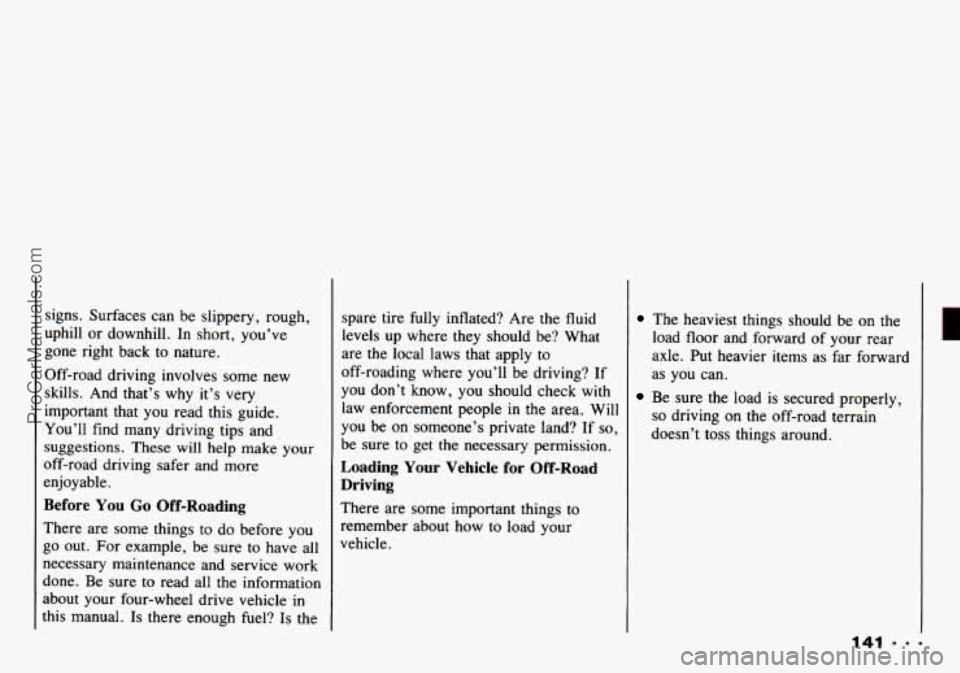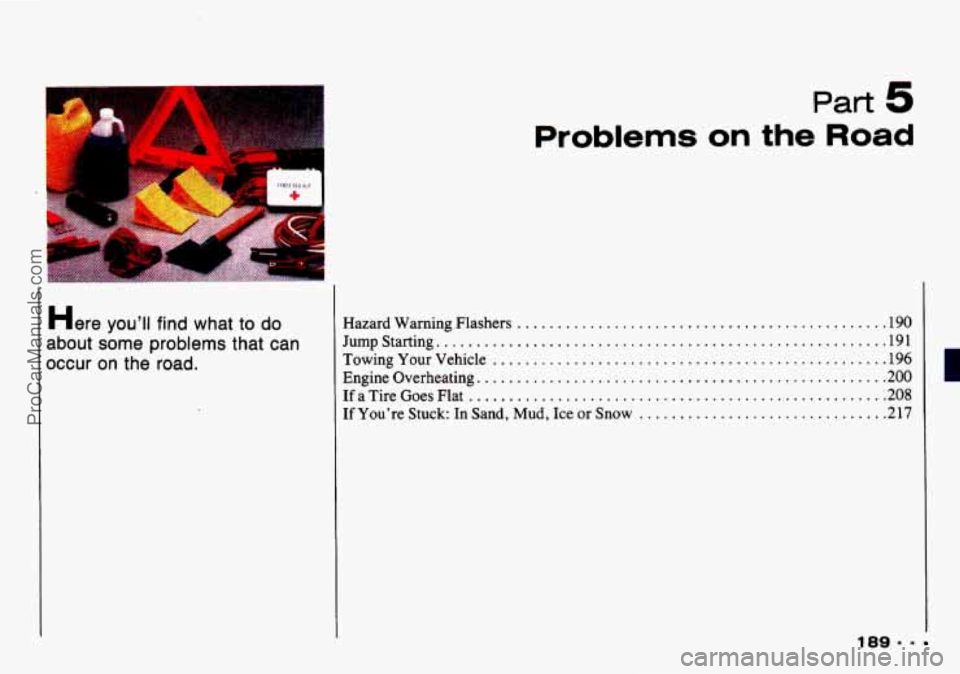1993 CHEVROLET TRACKER flat tire
[x] Cancel search: flat tirePage 8 of 339

How to Use this Manual
Part 5: Problems on the Road
This part tells you what to do if you
have a problem while driving, such as a
flat tire or engine overheating.
Part 6: Service & Appearance Care
Here the manual tells you how to keep
your Geo running properly and looking
good.
Part 7: Maintenance Schedule
This part tells you when to perform
vehicle maintenance and what fluids and
lubricants
to use.
Part 8: Customer Assistance
Information
This part includes important information
3bout reporting safety defects and gives
you details about the “Roadside
4ssistance” program.
You will also find
mstomer satisfaction phone numbers
(including customer satisfaction numbers
for the hearing and speech impaired) as
well as
the mediationlarbitration
procedure. We’ve also included ordering
information for service publications in
this part.
Service Station Information
This is a quick reference of service
information. You can find it
on the last
page of this manual.
Safety Warnings and Symbols
You will find a number of safety
cautions in this book. We use yellow
and the word CAUTION to tell
you
about things that could hurt you if you
were to ignore the warning.
In the yellow caution area, we tell you
what the hazard is. Then we tell you what
to do to help avoid or reduce the
hazard. Please read these cautions.
If
you don’t, you or others could be hurt.
I.. 6
ProCarManuals.com
Page 143 of 339

signs. Surfaces can be slippery, rough,
uphill or downhill. In short, you’ve
gone right back to nature.
Off-road driving involves some new
skills. And that’s why
it’s very
important that you read this guide.
You’ll find many driving tips and
suggestions. These will help make your
off-road driving safer and more
enjoyable.
Before You Go Off-Roading
There are some things to do before you
go out. For example, be sure to have all
necessary maintenance and service work
done. Be sure
to read all the information
about your four-wheel drive vehicle in
this manual.
Is there enough fuel? Is the spare
tire fully inflated? Are the fluid
levels up where they should be? What
are the local laws that apply to
off-roading where you’ll be driving? If
you don’t
know, you should check with
law enforcement people in the area. Wil
you be on someone’s private land?
If so
be sure to get the necessary permission.
Loading Your Vehicle for Off-Road
Driving
There are some important things to
remember about how to load your
vehicle.
The heaviest things should be on the
load floor and forward of your rear
axle. Put heavier items as far forward
as you can.
Be sure the load is secured properly,
so driving on the off-road terrain
doesn’t
toss things around.
ProCarManuals.com
Page 169 of 339

I Driving a Long
Distunce
Although most long trips today are made
on freeways, there are still many made
on regular highways.
Long-distance driving on freeways and
regular highways is the same in some
ways. The trip has
to be planned and the
vehicle prepared, you drive at
higher-than-city speeds, and there are
longer turns behind the wheel. You’ll
l enjoy your trip more if you and your
vehicle are in good shape. Here are
some tips for a successful long trip.
Before Leaving on a Long Trip
Make sure you’re ready. Try to be well
rested. If you must start when you’re
not fresh
- such as after a day’s work
- don’t plan to make too many miles
that first part
of the journey. Wear
comfortable clothing and shoes you can
easily drive in.
Is your vehicle ready for a long trip? If
you keep it serviced and maintained, it’s
ready to go.
If it needs service, have it
done before starting out. Of course,
you’ll find experienced and able service
experts in Geo dealerships all across
North America. They’ll be ready and
willing to help
if you need it. Here
are some things you can check
before a trip:
Windshield Washer Fluid: Is the
reservoir full? Are all windows clean
inside and outside?
Wiper Blades: Are they in good
shape?
Fuel, Engine Oil, Other Fluids:
Have you checked all levels?
Lights: Are they all working? Are the
lenses clean?
Tires: They are vitally important to a
safe, trouble-free trip. Is the tread
good enough
for long-distance
driving? Are the tires all inflated
to
the recommended pressure?
167-9.
ProCarManuals.com
Page 171 of 339

What can you do about highway
hypnosis? First, be aware that it can
happen.
Then here are some tips:
Make sure your vehicle is well
ventilated, with a comfortably cool
interior.
Keep your eyes moving. Scan the
road ahead and to the sides. Check
your rearview mirrors frequently and
your instruments from time
to time.
This can help you avoid a fixed stare.
Wear good sunglasses in bright light.
Glare can cause drowsiness. But don’t
wear sunglasses at night. They will drastically reduce your overall
vision
at the very time you need all the
seeing power you have.
If you get sleepy, pull off the road
into a rest, service or parking area
and take a nap, get some exercise, or
both. For safety, treat drowsiness on
the highway as an emergency.
As in any driving situation, keep pace
with traffic and allow adequate
following distances.
--
A
Driving on steep hills or mountains is
different from driving in flat or rolling
terrain. If you drive regularly
in steep
country, or if you’re planning
to visit
there, here are some tips that can make
your trips safer and more enjoyable.
(See “Off-Road Driving’’
in the Index
for information about driving off-road.)
Keep your vehicle in good shape.
Check all fluid levels and also the
brakes, tires, cooling system and
transmission. These ‘parts can work
hard on mountain roads.
ProCarManuals.com
Page 182 of 339

Your Driving and the Road
L
Weight of the Trailer Tongue
... 180
The tongue load (A) of any trailer is
an important weight to measure
because
it affects the total gross
weight of your vehicle. The gross
vehicle weight (GVW) includes the
curb weight of the vehicle, any cargo
you may carry in it, and the people
who will be riding in the vehicle. And
if
you will tow a trailer, you must add
the tongue load to
the GVW because
your vehicle will be carrying that
weight, too. See “Loading Your
Vehicle’’ in the Index for more
information about your vehicle’s
maximum load capacity. The trailer
tongue (A) should weigh
10%
of the total loaded trailer weight
(B). After you’ve loaded your trailer,
weigh the trailer and then the tongue,
separately, to see if the weights are
proper. If they aren’t, you may be
able to get them right simply by
moving some items around in the
trailer.
Total Weight on Your Vehicle’s
Tires
Be sure your vehicle’s tires are
inflated to the limit for cold tires.
You’ll
find these numbers on the
Certification label at the rear edge of
the driver’s door (or see “Tire Loading”
in the Index). Then be sure
you won’t go over the GVW limit for
your vehicle.
Hitches
It’s important to have the correct hitch
equipment. Crosswinds, large trucks
going by, and rough roads are a few
reasons why you’ll need the right hitch.
Here are some rules to follow:
Will you have to make any holes in
the body of your vehicle when
you
install a trailer hitch? If you do, then
be sure to seal
the holes later when
you remove the hitch. If you don’t
seal them, deadly carbon monoxide
ProCarManuals.com
Page 191 of 339

R
Here you’ll find what to do
about some problems that can
occur
on the road.
Problems on the Road
Hazard Warning Flashers . . . . . . . . . . . . . . . . . . . . . . . . . . . . . . . . . . . . . . . . . . . . . .190
rumpstarting ........................................................ 191
I‘owingYourVehicle ................................................. 196
3ngineOverheating
................................................... 200
[faTireGoesFlat .................................................... 208
[f You’re Stuck: In Sand, Mud, Ice or Snow . . . . . . . . . . . . . . . . . . . . . . . . . . . . . . .217
189- -
ProCarManuals.com
Page 210 of 339

Problems on the Road
Zf a Tire Goes Hut
Then replace the pressure cap. Be
sure
the ears on the pressure cap line
up like
this.
9 208
It’s unusual for a tire to “blow out’’
while you’re driving, especially
if you
maintain your tires properly. If air goes
out of a tire, it’s much more likely to
leak out slowly. But if you should ever
have a “blowout,
” here are a few tips
about what to expect and what to do:
If a front tire fails, the flat tire will
create a drag that pulls the vehicle
toward that side. Take your foot off the
accelerator pedal and grip the steering
wheel firmly. Steer to maintain lane
position, then gently brake to a stop well
out of the traffic lane.
A rear blowout, particularly on a curve,
acts much like a skid and may require
the same correction you’d use
in a skid. In any
rear blowout, remove your
foot
from the accelerator pedal. Get the
vehicle under control by steering
the
way you want the vehicle to go. It may
be
very bumpy and noisy, but you can
still steer. Gently brake to a stop, well
off the road
if possible.
If your tire goes flat, the next section
shows how to use your jacking
equipment to change a flat tire safely.
ChanginQ a Flat lire
If a tire goes flat, avoid further tire and
wheel damage by driving slowly to a
level place. Turn
on your hazard
warning flashers.
..
ProCarManuals.com
Page 213 of 339

Insert your key into the wheel lock and
pull the wheel lock
off.
Remove wheel nuts with the wheel
wrench.
Remove the spare tire from the
mounting bracket and place it near your
flat tire.
Attach the jack handle to the jack bolt.
Rotate the jack handle clockwise (to the
right). That will raise the lift head a
little. Using
the wheel wrench, loosen all the
wheel nuts. Don’t remove them yet.
211
ProCarManuals.com